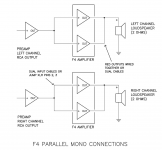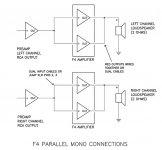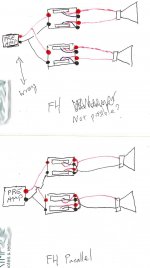my edit... I have four F4 boards to build two stereo bridged amps - I'm not exactly sure how to wire them for this but before I get to that point I'm wondering about the heat. I live in a hot climate and have no intention of running these for about 6 months of the year. end /edit
I can't imagine getting anything is free but would making a pair of F4 monoblock's capable of the 100W per channel (into 8 ohm speakers, not sure what the numbers are for 4 ohm speakers in this mode) bridged from a balanced input generate more heat compared to running them without a balanced input and "settle" with 50WPC?
Or is the heat going to be the same regardless?
The 4U 300mm chassis seems to be at its limit as far as heat dissipation goes.
A couple of weeks ago, I got ONE channel biased but with the chassis open I read 144F (62.2C) on the outside of the heatsink. The heatsink was in the proper orientation, but not raised above the desktop so it may have been capable of running a couple of degrees cooler with improved convection along the outside fins.
That was after almost two hours of warmup and adjusting then listened to an album. The source wasn't that great, but it sounded pretty good. I was surprised that is the quietest my system has been in regards to background noise, mild hum, etc.
Upgrading to 5U heatsinks may not go over so well at home. I have considered replacing the top chassis frame piece which holds the heatsink to the front/rear/back/front panels with a 300mm long "slice" of heatsink (about 40mm "tall" / 1U), fins facing inward, back of heatssink to back of heatsink and mounted above the F4 PCB's. I have other ideas, such as copper sheet mounted in a similar position.
A balanced preamp isn't going to be cheap and I'm wondering if I should live with "half" the power. Part of the decision will be based on if there is more heat that needs to be dissipated.
I can't imagine getting anything is free but would making a pair of F4 monoblock's capable of the 100W per channel (into 8 ohm speakers, not sure what the numbers are for 4 ohm speakers in this mode) bridged from a balanced input generate more heat compared to running them without a balanced input and "settle" with 50WPC?
Or is the heat going to be the same regardless?
The 4U 300mm chassis seems to be at its limit as far as heat dissipation goes.
A couple of weeks ago, I got ONE channel biased but with the chassis open I read 144F (62.2C) on the outside of the heatsink. The heatsink was in the proper orientation, but not raised above the desktop so it may have been capable of running a couple of degrees cooler with improved convection along the outside fins.
That was after almost two hours of warmup and adjusting then listened to an album. The source wasn't that great, but it sounded pretty good. I was surprised that is the quietest my system has been in regards to background noise, mild hum, etc.
Upgrading to 5U heatsinks may not go over so well at home. I have considered replacing the top chassis frame piece which holds the heatsink to the front/rear/back/front panels with a 300mm long "slice" of heatsink (about 40mm "tall" / 1U), fins facing inward, back of heatssink to back of heatsink and mounted above the F4 PCB's. I have other ideas, such as copper sheet mounted in a similar position.
A balanced preamp isn't going to be cheap and I'm wondering if I should live with "half" the power. Part of the decision will be based on if there is more heat that needs to be dissipated.
Last edited:
would making a pair of F4 monoblock's capable of the 100W per channel bridged
from a balanced input generate more heat compared to running them without
a balanced input and "settle"with 50WPC? Or is the heat going to be the same regardless?
You'll need two amp channels if running in the standard stereo mode,
but four channels are needed for a bridged stereo mode.
So the total power used would be twice as much for the bridged stereo mode.
You can always start with two channels and see if that's enough, using your old preamp.
Last edited:
IIRC, heat is a function of bias level and the class A amps may actually cool a bit when putting energy into the speakers instead of their heat sinks. I run my F4 at 180mv and it gets very hot to the touch during the summer. It wouldn't burn you immediately, but keeping your hands on it too long would be bad. During the winter I could keep my hands on it indefinitely. I vaguely remember backing the bias off a bit when I set mine up, both for heat and because I liked the lower bias point better. I remember it sounding very sterile when I raised the bias higher. I still liked it a lot, just not as much  .
.
No if you have an amp capable of 50W into 8ohms it will typically put out a little less than
twice as much into 4 ohms. For the sake of argument lets say our amp will just put out 90W into 4 ohms. When we bridge them we double the voltage swing but now each amp
does not see an 8 ohm load but a 4 ohm load. So we get not twice the power but close to 4 X the power so we would get something like 360 W not 100w .
twice as much into 4 ohms. For the sake of argument lets say our amp will just put out 90W into 4 ohms. When we bridge them we double the voltage swing but now each amp
does not see an 8 ohm load but a 4 ohm load. So we get not twice the power but close to 4 X the power so we would get something like 360 W not 100w .
The comparison is heat from a single F4 run single ended vs a single F4 run balanced. He wants to know if the 4u case can take the heat from running the amp balanced. Two F4s ( one per speaker ) would of course be required - which would be twice the heat, and twice the heatsinks to dissipate it  . I'm going to wager, even with my limited knowledge, that the answer is that the 4u case is more than adequate to run the F4 inside it balanced without adjustment - otherwise the commercial F4s wouldn't be configurable in that fashion.
. I'm going to wager, even with my limited knowledge, that the answer is that the 4u case is more than adequate to run the F4 inside it balanced without adjustment - otherwise the commercial F4s wouldn't be configurable in that fashion.
Thanks for clarifying. All replies address two questions which I am was struggling with, and I'm sure it would help if I would apply the V I R laws on a daily basis until they are second nature and not confusing.
I don't know the heat dissipation of the First Watt heatsinks in comparison with the type sold in DIYAudioStore but suspect with the various quotes I have read from Pass of "more is better" that Pass didn't skimp. Somewhere I've read they were costly to manufacture.
With the response that just went through a few seconds ago from ZenMod I have more assurance the heatsinks are adequate.
A few years ago I toasted an integrated amp I had been using for over 25 years by running 2 pairs of speakers at once. The amp had a switch on the back for an 8 ohm load or 4 ohm load and a selector for outputs of speaker pair 1, speaker pair 2, and speaker pair 1+2. I had 4 x 6 ohm speakers I was running (I think in parallel, but it was the wrong way) which would have presented a strenuous load on the amp even if I had used the 4 ohm setting. I was unaware I had switched it to the 8 ohm setting and that might have been what killed the poor amp. I would like to avoid a mistake like that.
As I often do, I hijack even the thread I started to clarify something which I see as being related but maybe it isn't.
The "who cares" reply suggests I have nothing to worry about as long as I hook things up correct.
The question of am I going to build them as two SE channels or Balanced; I want to see if running them as two SE channels will give me "enough", or better sound (opinions welcome) compared to the necessity of building a balanced preamp.
For now, I want to keep the crossover network that is built into the pair of speakers and not complicate things (my perspective) by converting the speakers to be bi-amped.
If I'm building these as described - borrowing from the First Watt Owners and Service Manual. Here is the diagram for driving 2 ohm speakers.

I can post additional links if this isn't the best route... it's just the one that is almost making sense to me at this point.
The outputs + are tied together at the amp, or bring two pairs of speaker wire.
Like most commercial speakers I have a + and - terminal on the back of the cabinet. I would like to confirm what I remember from a phone conversation a couple of years ago. Both individual outputs + would occupy a terminal on the back of the speaker... But that conversation was based on the old plan of building a balanced preamp... not two single ended monoblocks.
Using the above diagram for SE, it appears to me that the ground must return to the amplifier's "black" terminal.
Thanks for the help once again.
I don't know the heat dissipation of the First Watt heatsinks in comparison with the type sold in DIYAudioStore but suspect with the various quotes I have read from Pass of "more is better" that Pass didn't skimp. Somewhere I've read they were costly to manufacture.
With the response that just went through a few seconds ago from ZenMod I have more assurance the heatsinks are adequate.
A few years ago I toasted an integrated amp I had been using for over 25 years by running 2 pairs of speakers at once. The amp had a switch on the back for an 8 ohm load or 4 ohm load and a selector for outputs of speaker pair 1, speaker pair 2, and speaker pair 1+2. I had 4 x 6 ohm speakers I was running (I think in parallel, but it was the wrong way) which would have presented a strenuous load on the amp even if I had used the 4 ohm setting. I was unaware I had switched it to the 8 ohm setting and that might have been what killed the poor amp. I would like to avoid a mistake like that.
As I often do, I hijack even the thread I started to clarify something which I see as being related but maybe it isn't.
The "who cares" reply suggests I have nothing to worry about as long as I hook things up correct.
The question of am I going to build them as two SE channels or Balanced; I want to see if running them as two SE channels will give me "enough", or better sound (opinions welcome) compared to the necessity of building a balanced preamp.
For now, I want to keep the crossover network that is built into the pair of speakers and not complicate things (my perspective) by converting the speakers to be bi-amped.
If I'm building these as described - borrowing from the First Watt Owners and Service Manual. Here is the diagram for driving 2 ohm speakers.
I can post additional links if this isn't the best route... it's just the one that is almost making sense to me at this point.
The outputs + are tied together at the amp, or bring two pairs of speaker wire.
Like most commercial speakers I have a + and - terminal on the back of the cabinet. I would like to confirm what I remember from a phone conversation a couple of years ago. Both individual outputs + would occupy a terminal on the back of the speaker... But that conversation was based on the old plan of building a balanced preamp... not two single ended monoblocks.
Using the above diagram for SE, it appears to me that the ground must return to the amplifier's "black" terminal.
Thanks for the help once again.
Attachments
What kind of speakers? What stated efficiency rating?
I found this useful:
http://www.diyaudio.com/forums/mult...much-voltage-power-do-your-speakers-need.html
If I did the test correctly, it indicated that my speakers ( Canton CT-1000 ) would be splitting ear drums past 3 volts. They're rated by the manufacturer at 93db. The single F4 is more than enough. They are also 4ohm, circa 1983. Made in W Germany . The single F4 is more than enough to drive them, even in a large room.
. The single F4 is more than enough to drive them, even in a large room.
I found this useful:
http://www.diyaudio.com/forums/mult...much-voltage-power-do-your-speakers-need.html
If I did the test correctly, it indicated that my speakers ( Canton CT-1000 ) would be splitting ear drums past 3 volts. They're rated by the manufacturer at 93db. The single F4 is more than enough. They are also 4ohm, circa 1983. Made in W Germany
I intend on driving one pair of what are listed as 4 ohm nominal speakers, circa 1983.
OK, we got that
next - what is the question , sweet and short ?
What kind of speakers? What stated efficiency rating?
Nothing special, old Infinity RS-IIIb, I want to say 87db to 89db. I drive them to clipping weekly (rocking after a few drinks) with an Adcom. Too nervous to try that test as I made smoke a couple of years ago trying it.
OK, we got that
next - what is the question , sweet and short ?
Who am I?
Do you enjoy a good barrel aged distilled product?
Oh, that question...
Is this another way of interpreting the wiring schematic? (original first)
Attachments
upper part of your drawing is , well , rubbish - neither parallel nor proper bridged
lower part of your drawing is sort of correct way for parallel
now ........ if you obtain one F4 (with adequate preamp) , you can make few tests and decide:
-is it normal 50W/4R connection enough
-or you need 50W/2R (two channels paralleled )
-or you need (almost) 200W/4R (two channels bridged)
for first two tests you need unbalanced pre capable of 40Vpp output
for last one test you need bal. pre capable of almost 80Vpp output
for last two tests you'll be able to conduct just one channel test , if you have just one (common type - meaning 2 SE channels ) stereo F4
lower part of your drawing is sort of correct way for parallel
now ........ if you obtain one F4 (with adequate preamp) , you can make few tests and decide:
-is it normal 50W/4R connection enough
-or you need 50W/2R (two channels paralleled )
-or you need (almost) 200W/4R (two channels bridged)
for first two tests you need unbalanced pre capable of 40Vpp output
for last one test you need bal. pre capable of almost 80Vpp output
for last two tests you'll be able to conduct just one channel test , if you have just one (common type - meaning 2 SE channels ) stereo F4
- Status
- This old topic is closed. If you want to reopen this topic, contact a moderator using the "Report Post" button.
- Home
- Amplifiers
- Pass Labs
- Heat generated with bridged F4's? Balanced vs not


